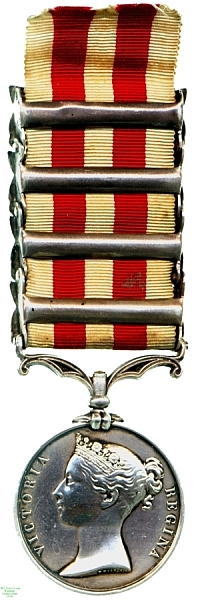
Obverse, a bust of Queen Victoria

Reverse, Britannia before a lion standing facing left, she with a wreath in her right hand

Obverse, a bust of Queen Victoria |

Reverse, Britannia before a lion standing facing left, she with a wreath in her right hand |
The Indian Mutiny of 1857, now regarded in some quarters of India as the First Indian War of Independence, has a history far too complex to be fairly explained here. In briefest summary, resentment at British snubbing of both Hindu and Muslim religious practices among the Sepoy (indigenous) troops of the British East India Company, whose complaints were regarded as mere superstitious nonsense by the European officers of the Company, became the spark that ignited a metaphorical powder keg of Bengali and Northern Indian resentment at the Company's taxation policies, its ever-more-extensive expropriations of Indian landowners' and rulers' territories under threat of arms, and its rearrangement of the Indian economy to suit the Company's entirely commercial interests.
Initial arson attacks and insubordination in early 1857 were followed by whole-unit mutinies and before long coordinated attacks by indigenous soldiery on Europeans in Indian towns. Full-scale war followed, and an initially-slow British resistance, still aided by many Indian troops, entailed perhaps as vicious a set of atrocities against the rebels as they or their civilian cohorts had committed against Europeans. Indian forces were uncoordinated, despite Bahadur Shah Zafur, Emperor of the Mughal rump state around Delhi, being proclaimed Emperor of all India and Sepoy rebels rallying to his standard. British and pro-British forces had secured the country again by mid-1858, and a programme of purges that became known as "the Devil's Wind", including thousands of executions, sometimes of whole village populations, attempted to ensure that the event would not be repeated. Bahadur Shah was exiled to Rangoon, and the East India Company's rule taken over directly by the British Crown.
One of the first British counter-moves was to send two columns to Delhi, where Bahadur Shah's rule offered an obvious target. A battle against the main rebel force at Badl-ke-Serai drove the Sepoys back onto Delhi and the British there besieged them as far as possible, this and their artillery support not being sufficient to take the city before two months had passed.
Elsewhere in India, the British garrison at Lucknow, in the recently-annexed state of Oudh, was warned of the rising in time to fortify the British Residency. Despite a 90-day siege in which the Sepoy opposition brought up artillery and in which the 1700 British or loyalist troops were reduced to 650 fit for battle, the Residency was held, although an initial relief expedition could not lift the siege and had to join the garrison for a further month of siege. Lucknow was finally relieved in October 1857, evacuated and retaken in 1858.
Although most of the fighting in the rebellion took place in Bengal and the North, Rani Lakshmi Bai, widow of the Raja of Jhansi whose state had been annexed by the East India Co. in 1853 under the controversial Doctrine of Lapse, used the rebellion to attempt to regain power in her Central Indian state. Her attempts to safely expel the British from her city, whose sincerity has been questioned, failed, and thereafter she had not only to face invasions from the neighbouring Rajas of Datia and Orccha but, with those repelled, an implacable British campaign against her. Jhansi fell in March 1858 after a short siege, but Lakshmi Bai escaped. Her substantial but poorly-equipped forces gave battle in vain at Kalpi in May 1858, and then fell back to Gwalior, which they captured from its loyalist Scinde rulers on 1st June. Here the Rani's luck finally ran out when she was killed in the first days of the subsequent British siege later in the month.
As the defence of Lucknow and the siege of Delhi were contemporaneous, no-one could receive all five of the bars that were issued for this medal, but it was possible to earn four by participating in all of the siege of Delhi, the relief of Lucknow, its subsequent recpature and the final defeat of the Jhansi forces of Lakshmi Bai. Of the 49 Europeans and 79 Indians so entitled, one was Corporal Patrick Keays of the 1st Battalion, Bengal Artillery, whose medal this is; its award has been verified. Lester Watson purchased it some time before 1928.